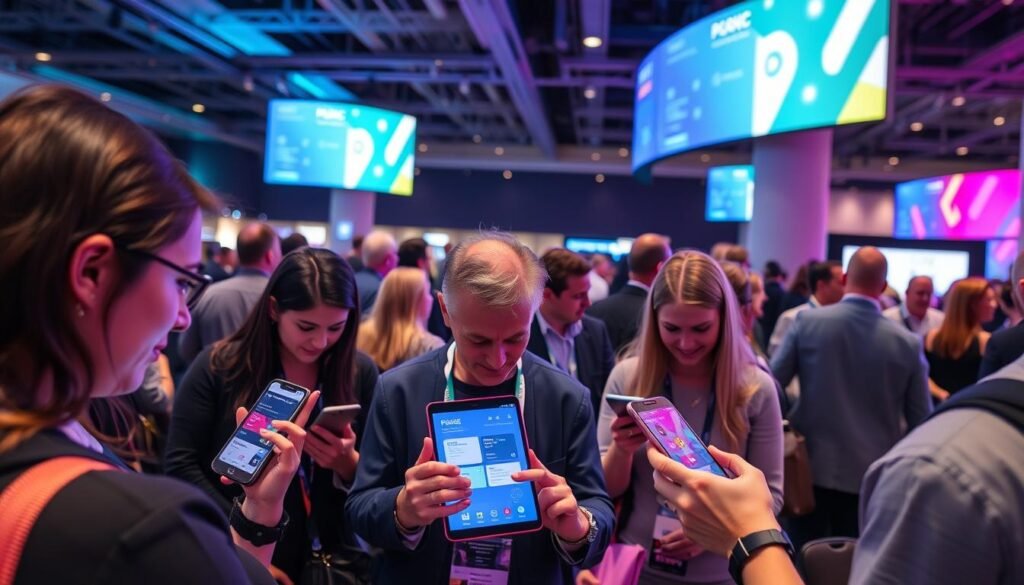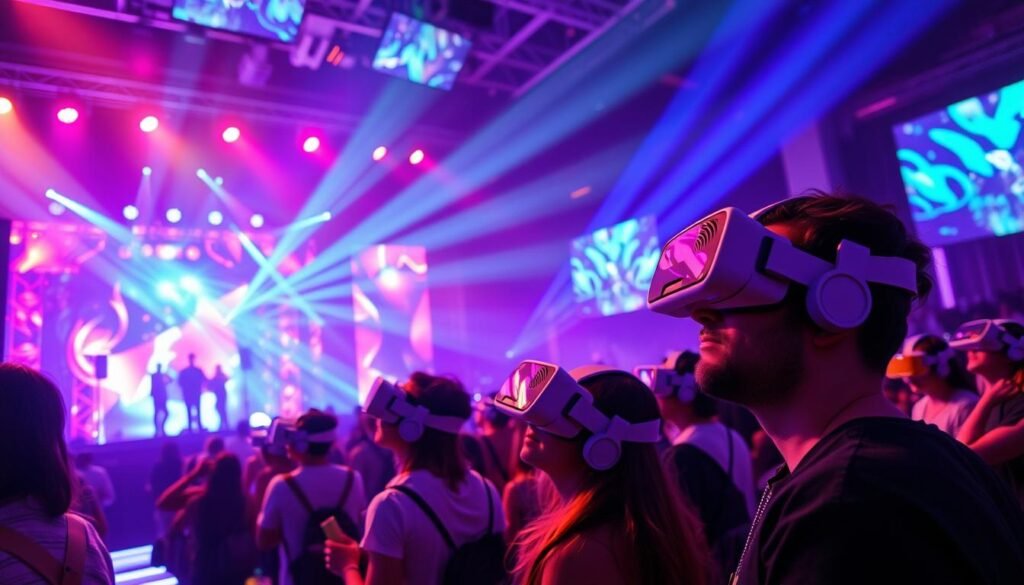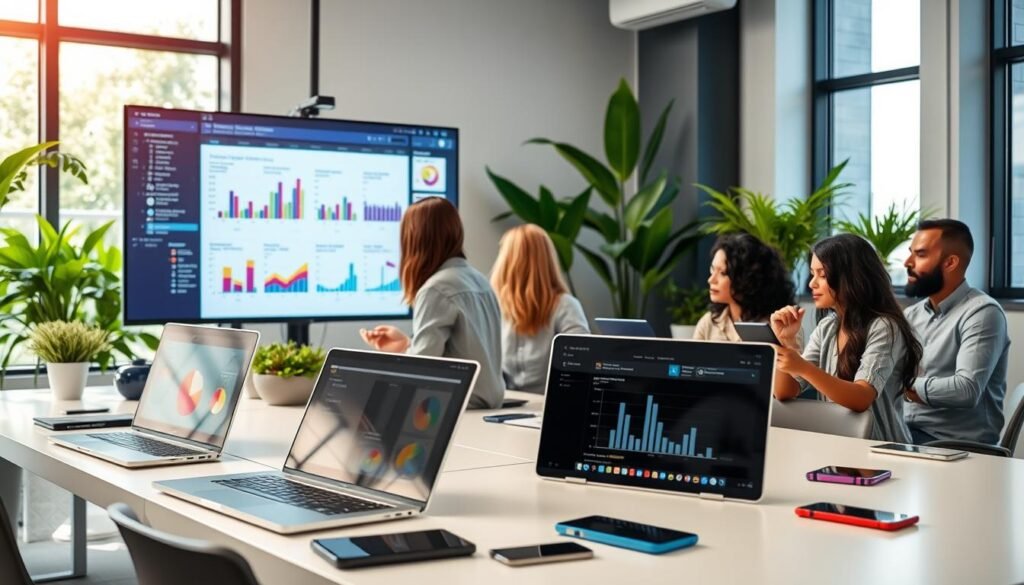טכנולוגיית אירועים חיונית ליצירת אירועים חיים וזוכרים. פתרונות מתקדמים משנים את דרך התכנון והחוויה של האירועים. אלה כוללים תצוגות אינטראקטיבטיות, שמע סוחף, מציאות וירטואלית, ונתוני ניתוח זמן אמת.
מארגנים יכולים לשפר השתתפות המשתתפים ולמסור חוויות בלתי נשכחות באמצעות טכנולוגיית אירועים חדשנית. הם יכולים גם לקבל תובנות יקרות כדי לשפר את האירועים שלהם. הישארות מעודכנים עם הכלים הטכנולוגיים האחרונים היא מפתח ליצירת אירועים מצטיינים.
בואו נגלה את כמה נקודות של טכנולוגיית אירועים חיים. נבחן כלים אינטראקטיביים לשיפור השתתפות המשתתפים. נדון גם בחוויות סוחפות המופעלות על ידי מציאות ומציאות מדומה.
תובנות מבוססות נתונים וניתוחים לקבלת החלטות מושכלות ייכללו. לבסוף, נבחן פתרונות מובנים לניהול אירועים כדי לפשט את תהליך התכנון.
מסקנות מרכזיות
-
טכנולוגיית אירועים חיים מהפכה את תעשיית האירועים, ומספקת כלים לשיפור השתתפות המשתתפים וחוויות שלא נשכחות.
- תצוגות אינטראקטיביות, צליל אימרסיבי, מציאות רבות, ונתוני ניתוח זמן אמת הם בין הפתרונות החדישים ביותר שמהפכים את האירועים.
- ניצול טכנולוגיית אירועים חדשנית יכול לעזור למארגנים ליצור אירועים מצטיינים שמספקים ערך יוצא דופן למשתתפים.
- המאמר יחקור כלים אינטראקטיביים, חוויות אימרסיביות, תובנות מבוססות נתונים, ופתרונות ניהול אירועים משולבים.
- להישאר מול המקפצה עם טכנולוגיית האירועים האחרונה היא חיונית להצלחה בשוק התחרותי היום.
הכוח של טכנולוגיית אירועים חיים
טכנולוגיית אירועים חיים שינתה את דרך התכנון והחוויה של אירועים. היא משתמשת בכלים מתקדמים כדי ליצור חוויות מעוררות התעניינות למשתתפים. טכנולוגיה זו מקדמת הצלחת האירוע על ידי אפשרות לאינטראקציות אישיות ותקשורת חלקה.
טכנולוגיה חדשנית עוזרת למארגנים ליצור אירועים מרתקים שמשך את תשומת לב הקהל. זה משאיר רושם אחרון על המשתתפים. הצלחת האירוע תלויה כעת באימוץ של טכנולוגיות אלה.
טכנולוגיית אירועים חיים מעלה את שביעות רצון המשתתפים דרך כלים אינטראקטיביים. אפליקציות אירועים ניידות, גיימיפיקציה ואינטגרציה עם רשתות חברתיות יוצרים חוויות אישיות. כלים אלה עוזרים למשתתפים להתחבר ולקבל מידע רלוונטי.
המשתתפים יכולים להצטרף לפעילויות שמתאימות לתחומי העניין שלהם. זה מעלה בהם תחושה של ערכה והתעסקות. כתוצאה, רמות השביעות רצון והנאמנות עולות.
טכנולוגיית אירועים חיים מסוגלת להפוך אירועים רגילים לחוויות חידושיות. זה לא רק על הכלים עצמם, אלא על איך שהם משמשים ליצירת קשרים משמעותיים ורגעים זכורים עבור המשתתפים.
אימוץ של טכנולוגיית אירועים חיים הוא חיוני בתעשייה המתפתחת של היום.
ציפיות המשתתפים עולות, לכן מארגני האירועים חייבים לחדש ולספק חוויות מעניינות. השקעה בפתרונות מתקדמים עוזרת למארגנים להתבלט מהמתחרים.
טכנולוגיות רבות כמו מציאות מדומה ומורחבת, וידאו ב-360 מעלות, ו-שידור חי יוצרות אירועים ייחודיים. טכנולוגיות אלו עושות את האירועים חוויות שחייבים להשתתף בהן. הן עוזרות למארגנים להבדיל את עצמם בשוק.
טכנולוגיית אירועים חיים מספקת גם נתונים מועילים המבוססים על נתונים. מעקב בזמן אמת אחר המשתתפים מקבל נתונים על רמות ההתעניינות ומזהה פעילויות פופולריות. הנתונים הללו עוזרים למארגנים להתאים את האסטרטגיות שלהם במהירות.
ניתוח לאחר האירוע נותן סקירה מלאה של ביצועי האירוע. הוא מדגיש אזורים לשיפור והזדמנויות צמיחה. מידע זה חיוני לתכנון של אירועים עתידיים.
טכנולוגיית אירועים חיים משנה את הדרך בה אנו חווים וניהלים אירועים. היא יוצרת חוויות בלתי נשכחות שמעלות את שביעות רצון המשתתפים.
ולשפר הצלחת האירוע. עם התקדמות הטכנולוגיה, האפשרויות לשיפור האירועים החיים אינסופיות.
מעורר עניין אצל המשתתפים בעזרת כלים אינטראקטיביים
האירועים החיים צריכים לשמור על מעורבות המשתתפים להצלחה. כלים אינטראקטיביים יוצרים חוויות סוחפות שמשך את תשומת לב הקהל. טכנולוגיות אלה משנות את האופן שבו המשתתפים מתקשרים עם האירועים ועם עצמם.
אפליקציות אירועים ניידות
אפליקציות אירועים ניידות שינו את האופן שבו המשתתפים מתעסקים באירועים חיים. הן מספקות סדר יום אישי, מפות ועדכונים בזמן אמת. מארגנים יכולים ליידע את המשתתפים על שינויים והזדמנויות דרך התראות דחיפה.
אפליקציות אירועים מאפשרות גם רשתות דרך הודעות באפליקציה ואינטגרציה עם רשתות חברתיות. הן עוזרות לבנות קשרים וליצור קהילת אירוע דינמית.

גיימיפיקציה ותחרויות
גיימיפיקציה ותחרויות מעוררות השתתפות של המשתתפים בצורה יעילה. ניקוד, טבלאות מובילים ואתגרים מעוררים את התשוקה של המשתתפים להצטרף לסשנים ולבקר בתערוכות. פרסים משפרים את התחושה של תחרותיות ורוח ספורט בקרב המשתתפים.
הפרסים יכולים לכלול גישה לתוכן בלעדי, מוצרים, או פריטים ערכיים. זה יוצר תחושת הישג למשתתפים מעורכים.
אינטגרציה של רשתות חברתיות
רשתות חברתיות הן חשובות לאירועים חיים. זה מאפשר שיתוף פעולה בזמן אמת של מחשבות ותמונות. האשטגים המיוחדים לאירוע וקירות רשתות חברתיות מעודדים השתתפות רחבה יותר.
תוכן שנוצר על ידי המשתמשים משמש כעדויות אותנטיות לשיווק בעתיד. אינטגרציה של רשתות חברתיות מגבירה מודעות למותג ומרחיבה את הטווח של האירוע מעבר למקום האירוע.
"כלים אינטראקטיביים כמו אפליקציות אירועים, גיימיפיקציה ואינטגרציה של רשתות חברתיות שינו את הדרך בה אנו מעוררים את המשתתפים באירועים חיים. טכנולוגיות אלו לא רק משפרות את חוויית המשתתפים אלא גם מספקות נתונים ותובנות ערך למארגני האירועים כדי לשפר באופן רציף את האסטרטגיות שלהם." – שרה ג'ונסון, מומחית בטכנולוגיות לאירועים
כלים אינטראקטיביים יוצרים סביבה דינמית ששומרת על המשתתפים מוטיבים ומחוברים. הם משפרים את חוויית האירוע ומספקים נתונים ערכיים. הנתונים הללו עוזרים לשפר את אסטרטגיות האירועים בעתיד כדי ליצור חוויות עוצמתיות יותר.
מניעת טכנולוגיית אירועים חיים עבור חוויות סוחפות
טכנולוגיית אירועים חיים שינתה את הדרך שבה אנשים מתעסקים באירועים. היא יוצרת חוויות מרתקות ואינטראקטיביות באמצעות כלים מתקדמים. מציאות רבודה, מציאות מדומה, ושידור חי הם תחומים מרכזיים שמשפיעים בצורה גדולה.
מציאות רבודה ומציאות מדומה
מציאות רבודה ומציאות מדומה משנות את האירועים החיים עם חוויות סוחפות. מציאות רבודה יוצרת אולמות ודמויות וירטואליות שמעבירות את המשתתפים לעולמות חדשים. מציאות מדומה משפרת את המרחבים הפיזיים על ידי ניתוב תוכן דיגיטלי, משלבת אלמנטים אמיתיים ווירטואליים.
טכנולוגיות אלו מאפשרות גם השתתפות מרחוק. אנשים שאינם יכולים להשתתף פיזית עדיין יכולים להיות מעורבים באופן משמעותי. זה מפגין את האירועים יותר כוללים ונגישים לקהל רחב יותר.

וידאו 360 מעלות ושידור חי
וידאו 360 מעלות ו-שידור חי יוצרים חוויות מרהיבות באירועים חיים. הם מספקים ל-קהלים מרוחקים חוויית אינטראקטיבית, כאילו הם שם. המשתתפים יכולים לחקור את המרחב של האירוע ולצפות בהצגות מזוויות מרובות.
השידור החי מסייע לאירועים להגיע לקהל גלובלי. זה מבטיח גישה לתוכן למשתתפים מרוחקים בזמן אמת. זה מגביר את ההשפעה והערך של האירוע, מגיע לשווקים ולדמוגרפיות חדשים.
"השילוב של מציאות וממוצעת מדרג, יחד עם וידאו 360 מעלות ושידור חי, פתח דרכים חדשות ליצירת חוויות מרהיבות ומעוררות התעניינות באירועים חיים. טכנולוגיות אלה משנות את הדרך בה אנו מתחברים, לומדים ומתקשרים, ועושות את האירועים נגישים, כוללים ומשפיעים יותר מתמיד."
טכנולוגיית אירועים חיים מתפתחת עם יישומים חדשים של VR, AR ושידור חי. מארגני האירועים שמשתמשים בכלים אלה בצורה יעילה ייצרו חוויות שלא נשכחות. הם יצליחו בנופה המשתנה של האירועים על ידי התאמה לקהלים.
תובנות מבוססות נתונים וניתוחים
האירועים החיים עכשיו תלויים בתובנות מבוססות נתונים וניתוחים כדי לשפר את חוויות המשתתפים. מארגני האירועים משתמשים בטכנולוגיות מתקדמות כדי לאסוף מידע ערך על התנהגות ועדפי המשתתפים. המידע הזה עוזר לשפר את תכנון האירוע, ביצועו והערכתו.
מעקב בזמן אמת אחר המשתתפים
טכנולוגיית RFID המהפכה במעקב אחר המשתתפים באירועים. מארגנים משתמשים בתגי RFID או צמידים עם RFID כדי למעקב אחר תנועת המשתתפים בזמן אמת. זה מספק מידע עשיר על ישיבות פופולריות, תערוכות של יצרנים ואזורי רשת.
טכנולוגיית RFID מאפשרת גם ניתוח תנועת רגליים ואופטימיזציה של מרחב. מארגנים יכולים לזהות אזורים עם עומס גבוה ולבצע אופטימיזציה בהתאם.
החלטות מבוססות נתונים על מנת לשפר את חוויית הקהל בכלל. זה עשוי לכלול שינויים קלים בפריסת האירוע או בכרונולוגיה.
ניתוח ודיווח לאחר האירוע
ניתוח לאחר האירוע חיוני למדידת הצלחה ולזיהוי תחומים לשיפור. מארגני האירוע אוספים נתונים מסקרים, מדי המערכות החברתיות ומהניתוחים של השתתפות. גישה זו מקיפה עוזרת להבין את ביצועי האירוע בצורה כללית.
מדדים מרכזיים כמו שביעות רצון המשתתפים, שעות ההשתתפות בסשנים והחזר השקעה של התערכים מנותחים. התובנות הללו עוזרות למארגנים לקבל החלטות מושכלות לאירועים עתידיים. הם יכולים גם להראות לצדדים עניין את הערך וההשפעה של האירועים שלהם.
"החלטות מבוססות נתונים הן העתיד של תכנון האירועים. על ידי פיתוח כוח ניתוחי האירוע ומשוב המשתתפים, אנו יכולים ליצור חוויות מדהימות באמת שמרגשות את הקהל שלנו ומפיקות תוצאות מדידות." – שרה ג'ונסון, מומחית לתובנות אירועים
ניתוח לאחר האירוע עוזר לזהות את השיטות הטובות לאירועים עתידיים. מארגנים יכולים לשפר את גישתם על סמך התובנות המבוססות נתונים. זה מאפשר להם להיות בראש ולספק חוויות משפיעות יותר ויותר.
| מקור נתונים | מדדים עיקריים | תובנות שנרכשו |
|---|---|---|
| זיהוי RFID מעקב אחר משתתפים | תנועת רגליים, זמן שהמבקרים משהים, נוכחות בסשן | אופטימיזצית מרחב, התאמות בתוכנית |
| סקרי משתתפים | רמות שביעות רצון, ציון נטייה של הממליץ (NPS) | תחומים לשיפור, העדפות המשתתפים |
| ניתוחי מדיה חברתית | שיעורי התערבות, ניתוח רגשות | תמונת המותג, נושאים נטולי זמן |
| משוב מאתרי התערוכה | ייצור לידים, מדידת תמריצי ההחזר | ביצועי הסטנד, ערך התמיכה |
תובנות וניתוחים המבוססים על נתונים פותחים רמות חדשות של הבנה באירועים חיים. ממעקב בזמן אמת עד ניתוח לאחר האירוע, כלים אלה יוצרים חוויות יוצאות דופן. הם משאירים רושם שנשאר על המשתתפים ומפעילים תוצאות מדידות עבור ארגונים.
סידור ניהול האירועים בעזרת טכנולוגיה
תוכנת ניהול האירועים חיונית לתכנון וביצוע אירועים חיים ביעילות. היא אוטומטית משימות, חוסכת זמן ומפחיתה עלויות. כלים אלה עוסקים ברישום, מכירת כרטיסים, צ'ק-אין, ואיסוף לידים בצורה חלקה.
אוטומציה של משימות חוזרות היא יתרון מרכזי של תוכנה זו. מערכות מקוונות ניהלות מידע על משתתפים, תשלומים, ויצירת כרטיסים באופן מדויק. כלים באתר מקלים על צ'ק-אין ולוכדים מידע ערך על לידים בקלות.

התוכנה משתלבת עם פלטפורמות אחרות, מאפשרת זרימת נתונים חלקה. היא מתחברת למערכות שיווק אוטומציה ו-CRM עבור חוויות מותאמות אישית. השילוב הזה מספק תובנות בהתנהגות ובהעדפות המשתתפים.
"תוכנת ניהול אירועים הייתה משנה משחק עבור הארגון שלנו. היא מאפשרת לנו להתמקד במסירת תוכן מצוין ויצירת חוויות זכורות עבור המשתתפים שלנו, במקום להיכנע למשימות מנהליות." – שרה ג'ונסון, מנהלת אירועים בחברת XYZ
טכנולוגיה משפרת את חוויית המשתתפים באירועים. אפליקציות ניידות, סדר יום אישי, ועדכונים בזמן אמת שומרים על המשתתפים מעודכנים ומעוררים עניין. ההתערבות המוגברת הזו מביאה לשביעות רצון גבוהה ולנאמנות גבוהה יותר בקרב המשתתפים.
| משימת ניהול אירועים | תהליך ידני | אוטומטי עם טכנולוגיה |
|---|---|---|
| רישום ומכירת כרטיסים | זמן רב ומסוכן לשגיאות | יעיל ומדויק |
| צ'ק-אין ואיסוף לידים | איטי ומסורבל | מהיר ומיושם |
| ניהול נתונים וניתוח | קשה ומוגבל | קל ומקיף |
ניהול אירועים טכנולוגיה משפרת את היעילות ושביעות רצון המשתתפים. זה מאפשר למארגנים להתמקד ביצירת חוויות זכורות. בסופו של דבר, זה מתרום להצלחה הכללית של האירוע.
מסקנה
טכנולוגיית אירועים חיים משתנה במהירות. זה עוצב את עתיד האירועים ואת אופן האינטראקציה של המשתתפים. מארגנים חייבים לעקוב אחרי מגמות הטכנולוגיה כדי לעמוד בציפיות המשתתפים.
כלים חדשניים יכולים ליצור חוויות אימרסיביות ואישיות. אפליקציות ניידות, גיימיפיקציה ואינטגרציה עם רשתות חברתיות משפרים את ההשתתפות. מציאות וירטואלית ונתונים אנליטיים משחקים גם הם תפקידים חיוניים.
טכנולוגיה מתקדמת משפרת את חוויית המשתתפים. זה גם נותן למארגנים יתרון תחרותי. הכלים הנכונים יכולים למשוך יותר משתתפים ולשמור על שותפויות שוות.
מסירת אירועים זכורים היא מפתח בשוק עמוס. מארגנים צריכים להישאר מעודכנים במגמות האחרונות. התאמה וחדשנות יוצרות חוויות מהפכניות עבור המשתתפים.
עתיד האירועים משלב טכנולוגיה, יצירתיות וחיבור אנושי. אלה שישליטו באיזון זה יצליחו. מקצוענים בתחום האירועים יכולים לתרום לצמיחתם ולהצלחתם של הארגונים.



